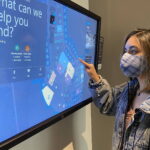 Editor’s note: We’ve republished this blog with a new companion video.
Editor’s note: We’ve republished this blog with a new companion video.
Sphoorti Patil is using Microsoft Azure indoor mapping and IoT technology that helps Microsoft employees find their way around the company’s campuses—and she hasn’t been in a Microsoft building yet.
She’s not alone in this experience—Microsoft has hired a number of new employees since the COVID-19 pandemic started, and most of them started and are continuing to work remotely (as are most of Microsoft’s approximately 190,000 employees globally).
“I went through my whole interview process virtually and never met my colleagues in person,” says Patil, a senior program manager in Microsoft Digital, the organization that powers, protects, and transforms the company. “Since employees like me don’t have onboarding buddies to show them around, we’re building software that can be their guide and help them locate things.”
We want to create employee experiences that adapt to meet the needs of this changing workforce. Employees can still build relationships and get coffee, but if they have a quick question, they have the option of using Microsoft Teams or meeting room software to sync and collaborate from anywhere.
—Michael Tiopan, app manager, Global Workplace Services
Flexibility is the name of the game as Microsoft, like other companies, considers when to have its employees start working in physical offices in some form in this new hybrid world of work that is emerging across the planet. To support this hybrid work model, the Global Workplace Services team at Microsoft is partnering with Microsoft Digital to transform the company’s employee experience from the inside out using Microsoft Azure Digital Twins and Microsoft Azure Maps.
Together, they’re designing employee experiences with ease and productivity in mind.
“We want to create employee experiences that adapt to meet the needs of this changing workforce,” says Michael Tiopan, an app manager in Global Workplace Services who works with employees in Microsoft Digital to support workplace management. “Employees can still build relationships and get coffee, but if they have a quick question, they have the option of using Microsoft Teams or meeting room software to sync and collaborate from anywhere.”
For a transcript, please view the video on YouTube: https://www.youtube.com/watch?v=Hx6BJNMx2bQ, select the “More actions” button (three dots icon) below the video, and then select “Show transcript.”That’s why it’s vital to rethink the workplace, which, at Microsoft, includes both buildings and the tools the company’s employees use on a day-to-day basis.
“Microsoft wants to improve space and occupancy planning to ensure that we offer our employees flexible experiences using indoor mapping and IoT technology,” Patil says.
This means employees can use kiosks to find offices, supply rooms, or cafés, or to log into a mobile application to do common tasks like submit time off or book focus rooms.
[Learn more about how Microsoft is creating a world-class, integrated experience for every employee. Watch this video to find out how Microsoft is using Azure Digital Twins and Internet of Things technology to optimize employee usage and facilities management of company buildings.]
Tracking real-time data and building visualizations
Tiopan says having most employees work remotely has enabled the company to speed up an already underway transformation of its large global building footprint using indoor mapping and IoT technology.
Having a channel for data ingestion is foundational to building out connected experiences for employees and optimizing space planning.
—Balaji Radhakrishnan, senior software engineer, Space Management team, Microsoft Digital
To understand space usage during the pandemic and beyond, the company accelerated the installation of IoT technology sensors in all its buildings. These sensors use anonymized data to track occupancy, temperatures, and more. This continuous supply of real-time data is ingested, tracked, and used by Microsoft Azure Digital Twins, which uses IoT data to create digital models of physical environments like Microsoft buildings.
“Having a channel for data ingestion is foundational to building out connected experiences for employees and optimizing space planning,” says Balaji Radhakrishnan, a senior software engineer on Microsoft Digital’s Space Management team.
“One of the biggest challenges to digital transformation is that data usually exists in siloes,” Patil says, “The IoT sensor data, which captures insights about current occupancy and building conditions, is funneled to Azure Digital Twins, which informs space planning at Microsoft.”
Radhakrishnan and Patil’s teams use Microsoft Azure Maps to transform computer-aided design (CAD) drawings into digital visualizations of rooms, hallways, and buildings, which are added into the digital replica created in Microsoft Azure Digital Twins.
This information is then displayed on kiosks that have a map of campus buildings. At Microsoft, this information is shown to employees as an interactive map that’s available through the company’s MyHub app and digital kiosks in Microsoft buildings. Available spaces are shown as green, which makes it easy for employees to find an open spot.
Tiopan says that Microsoft employees can reference this data to track usage and capacity, which enables real estate experts in Global Workplace Services to have proactive conversations with Microsoft leadership about occupancy planning, space utilization, and flexible hybrid workspaces based on activity patterns in the space usage data. Additionally, the data is useful in planning employee services and building maintenance.
Identify opportunities to leverage real-time data to automate any of your processes, and make sure that you’re addressing a customer need in the process.
—Sphoorti Patil, senior program manager, Microsoft Digital
One key use case is hot desking, which employees can use as a temporary workspace in a Microsoft building if they’re working remotely most of the time. An employee can go into MyHub, the mobile app for employee experiences, and look for available spaces they can reserve for their use. This feature uses space occupancy data that’s fed into Azure Digital Twins, which is used to create digital replicas of campus buildings that are displayed in physical kiosks and the company’s mobile app.
Standardization and optimization
Customers can use Microsoft Azure Digital Twins and Azure Maps to create real-time visualizations of physical spaces ranging from an employee office to a retail store. Before investing in building out the infrastructure to support IoT technology sensors, Patil suggests assessing your digital maturity by tracking what percentage of your business has manual versus automated processes.
“Identify opportunities to leverage real-time data to automate any of your processes, and make sure that you’re addressing a customer need in the process,” Patil says.
From there, ensure that you have a continuous supply of data that can be ingested by Microsoft Azure Digital Twins, as this is the foundation for digital transformation.
“Evaluate what technical infrastructure you need to support the real-time ingestion of data,” Patil says. “Once you have that, you can create virtual representations of physical buildings or simulations of supply chain management.”
The most important consideration is to assess what your end users want and build IoT technology solutions with those scenarios in mind.
“Focus on the needs of your end users before thinking about how to use IoT technology and Azure Digital Twins for space management and smart building services,” Patil says.

- Check out how Microsoft Azure Maps, Microsoft Azure Digital Twins and IoT technology sensors combine to provide real-time occupancy data and visualizations that are powerful planning tools for companies navigating the new hybrid workplace.
- Use Microsoft Azure Maps to create web and mobile applications that are powered by real-time location intelligence.
- Use research about your customers or end users to identify the IoT technology solutions you want to develop.
- Envisioning your end-to-end scenario can help companies create an architecture that provides a continuous supply of data that can be ingested by Microsoft Azure Digital Twins, which can be leveraged to power real-time indoor mapping experiences.









